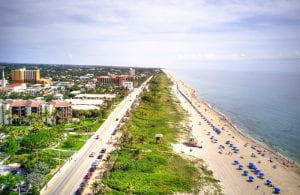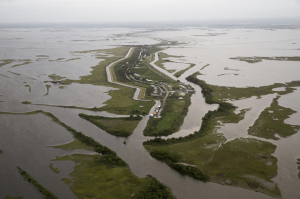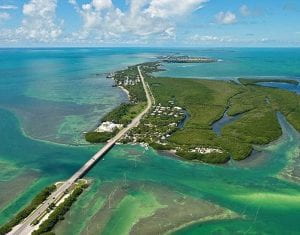Living with Water: How Residents of Delray Beach Perceive Risks While Living on the Coast
By: Devin Borg
I’ve grown up in a region that is projected to eventually slowly slip in and be swallowed up by the Atlantic Ocean. Florida is a peninsula with water on all three sides. Because of climate change this state is vulnerable, especially along its coast. By 2100, or with 4 feet of sea level rise, Florida is projected to see a loss of approximately 2,400 square miles of land – the size of about eight New York City’s. The coast of Southeast Florida – specifically, Delray Beach – is where I grew up and remain connected to. Delray Beach is located just 52 miles north of Miami, also on the east coast of Florida (on the Atlantic Ocean). This “Village by the Sea” is officially a city but its landscape looks more like a small beach town; one street that acts as our downtown or ‘main street’, and the surrounding areas are mostly residential.
VIDEO: Biking along downtown Delray
This grant provided me the support to be able to carry out the field work necessary for my thesis study, including a visit to my hometown of Delray Beach, Florida. This study allowed me to begin answering the research question of: what motivates coastal residents to continue living in at risk coastal places in the wake of climate change and how do they perceive the risks of living on the coast?
Florida’s population includes 19.6 million residents, 15 million of which reside along its coasts. Floridians may be fortunate to live among subtropical temperatures and an ocean breeze, among other benefits. However, the risks posed by climate change are becoming more apparent and dangerous. Vulnerabilities unique to South Florida include many of its counties built on top of porous limestone bedrock, its location perfectly positioned within Hurricane Alley, low lying land and elevation, and extreme temperatures. These are in addition to global hazards which will only exacerbate South Florida’s vulnerabilities further, such as a rising relative sea level and water table, further erosion to the coasts and natural buffers, a more vicious and frequent hurricane and storm season, and additional high tide events.
The study for this thesis relied heavily on a community outreach and fieldwork approach to explore how residents perceive risks due to climate change while living in a coastal community. An online survey, receiving 61 respondents, and a series of follow up interviews with 8 residents of Delray Beach provided insights into the motivations and thoughts of the residents. With these two methods the aim was to figure out what specific risks residents are most concerned about, their beliefs and views more generally on climate change, and why they choose to live on the coast despite the proven risks.
During this nearly year long project, the conflict between my views & knowledge on coastal retreat and long term & sustainable solutions, was shaken by this overwhelming sense of pride, joy, and commitment from either the residents I officially interviewed or people I came across during the outreach process. This desire and willingness to ‘stick it out’ even after experiencing some of the worst kinds of disaster events, is synonymous across the country. The land of Isle de Jean Charles in Louisiana, has disappeared by 98% since 1955. The Florida Keys is looking at 90% of its entire land mass only five feet or less above sea levels.
An online survey questionnaire was designed and accessible to residents via Qualtrics. Designing, formatting and wording the survey questionnaire provided to be a skill I had to develop and even post study, I am more aware and experienced about what goes into making a strong survey for a related social science study. The framing of the questions, the words and phrases chosen, and even the order and placement of which questions and categories should go where in the survey all were carefully considered and even tests on my peers and friends. Example of a few survey questions include:
- Will living on the coast become an issue for your community?
- To what extent did considerations of climate change influence your decision to move to Delray Beach, Florida?
- How much do you think the effects of climate change will harm your home and property?
Despite having taken little to no courses in statistical analysis and applied research methods, the process of analyzing the quantitative data from the 61 survey respondents as well as the data from the 8 in depth interviews was another valuable learning experience that even required the help of many different types of people, staff and professors from The New School community. This part of the study included many weeks preparing spreadsheets, running cross tabulations, analyzing distribution while creating frequency tables, and referring back to the four initial hypotheses. This is how four themes emerged.
An overwhelming 80% of the sample study had given no considerations at all to climate change when deciding to move to Delray Beach; even including residents who have recently moved there. Whether these residents moved for a job, family ties, or simply the small town charm, this finding suggests that the benefits outweigh the risks threatening their coast. The largest percentage from the sample believe that climate change impacts to their community pose a threat very soon. However, it is ironic that this same group feels they are receiving no protection from the threats climate change poses to them on the coast. Residents found the concept of climate change to be overwhelming when considering the timeline and future projections, especially what the timeline looks like for them on the coast. Proximity to the coast did elevate levels of risk perception and ownership for flood insurance. Lastly, the phenomenon of “snowbirds” – residents that migrate from up north during winter months, seeking warmth in Florida – and other types of part time residents differ from the full time residents – or ‘locals’. Part time residents included in the study were more willing to leave when impacts on the coast worsened, than the part time residents. There part time residents get to enjoy the benefits and soak up their time in the sunshine, and then are able to leave during the squelching summer season – usually avoiding hurricane season and many extreme weather events. This group might also not be as inclined to establish strong ties to the community and put down roots. This could pose a challenge when exploring the conversation around coastal adaptation policies and planning, when community is so split by a fluctuating, seasonal, and transient population.
Solutions and research surrounding policies tied to coastal managed retreat and alternative living locations to remain close to the coast, as well as innovative and more sustainable built and green infrastructure, needs to continue alongside exploration and discussions geared towards resident’s risk perception. Such an approach should be utilized for disaster planning and other types of communities vulnerable to climate change (such as droughts, extreme heat or air pollution). If aid to communities vulnerable to climate change is to be given, listening to why residents continue to stay there and for what benefits or reasons are they not willing to leave. I believe exploring the different levels of risk perception for coastal communities must to be worked into large city or state planning and reports.



